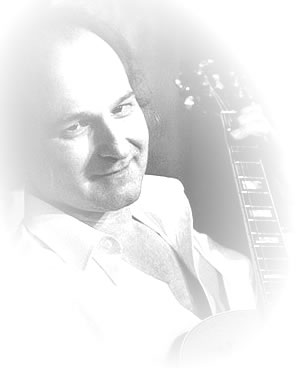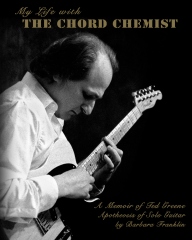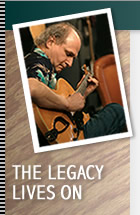| |
Fall 2025 • TedGreene.com Newsletter
ADVANCE TO NEW ITEMS >>

Fall Greetings to all Ted Greene fans, students, friends, and lovers of harmony!
As we welcome the fall season, we’re also taking a moment to remember Ted. In this newsletter, we’re sharing a few collected memories from his students, originally posted on the 2005 Ted Greene Memorial Blog.
We invite you to read these heartfelt reflections while listening to one of the newly released recordings of Ted playing at Joey Backenstoe’s wedding. It’s a beautiful way to honor his legacy and to hopefully inspire you to learn one of his arrangements or other music studies, and thereby become a better guitar player, and a better musician.
* * * * *
Ok - I’m going to take a whack at saying something about Ted – here goes.
What can one say about the most generous, contradictory, talented, musical, loving, unique, driven, romantic, frustrating, gentle, complex, spiritual, argumentative, humorous, earthy, shy, quirky, kind, puzzling, compassionate enigma we’ll ever know?
I know I don’t know.
Ted.
At the end you may have been ready. But damn it, we weren’t!
How are we supposed to learn our next lesson?
Where can we get those six-hour discussions of heaven, earth, Ted Williams, big block Chevy’s, Debussy, wound 3rd strings, ‘50s bop, and physics?
Where will the “Golliwogs Cakewalk” and “Gone with the Wind” wander across a fret board together with a laugh and a joke, and then submerge into a poignancy so stirring to leave us tearful?
Where will we talk about arch tops and the Lakers, George (Van Epps) and my kids in one breath?
Who will offer to help when one of life’s bumps hits one of us you left behind?
How many photocopy stores are going to go out of business?
Who will tell us the truth about our playing, but encourage us in the same breath?
Why weren’t we ready!?!
Who will pose those subtle questions, in lessons and outside, that lead us without knowing it to some new insight? (“What about a 3rd there…?”)
Where are we going to see your joy in rediscovering Columbo, Basil Rathbone in Sherlock Holmes, or Katie Couric?
And the obscure and beautiful books – gifts for some occasion but dearer for your enthusiasm and notes inside?
And those phone calls! Where can we call you while you talk to a student in the room - “No, 3rd finger...yeah, higher…okay, try it again.
Where were we? Oh yeah, Newton….”
And the diet Coke and lettuce and…well, can’t remember any of your other food groups.
You may have been ready at the end, but we weren’t.
What would you say to us now? How would you find a way, as in times past, to comfort us?
Honestly Theo, I don’t think even you could find a way.
Were you one-of-a-kind? I’d say so, but you’d say, “We all are.”
Friendship. Generosity. The music.
Old friend this is one time I can’t help thinking you let us down. But we forgive you.
Next time just raise your lesson prices, will ya!
And get a couple of more Hawaiian shirts – I mean, Geesh!
And above all, rest in peace.
~ Leon
* * * * *
I am shocked and deeply saddened at Ted’s passing. He was and still is one of my heroes as a guitarist, musician, and as a person. His talent was heads above even the best players, but he had such a gentle, sweet, and humble attitude about him that made you feel that he was your good friend and that he respected you. I studied privately with him for a about a year. He was very interested in the fact that I practiced the yoga meditation of Paramahansa Yogananda and Self-Realization Fellowship. He confided to me that he had studied the SRF Lessons, but regrated that he had stopped. He was very interested in spiritual and metaphysical aspects of life, and thought very highly of Yogananda. Some of our lesson time was spent talking about yoga meditation. I will forever cherish my contact with him.
~ Paul
* * * * *
Ted’s accomplishments on the guitar are a revelation. The one lesson I had with him ten years ago is still a source of inspiration and motivation.
Thank you, Ted, you will be missed.
~ Charlie Hunter
* * * * *
I remember some of the most beautiful music I ever heard...Ted was playing a 4-voice Bach fugue...on a Tele with a flatpick! Certainly, he was one of the gentlest and giving beings I’ve had the honor to know. I only wish I could be so.
Thanks Ted, goodbye for now.
~ Andrew
* * * * *
I truly loved Ted. He was one of the kindest and most generous persons I have ever known. For over 20 years I had had the privilege to study with Ted. He was such an outstanding and amazingly intellectual person, and we would talk for hours after my lesson was over about many non-musical related topics – and his passion and convictions always prevailed!
I sadly regret that just 3 days prior to his passing I had Ted on my mind and was going to call him to see if he had any available spots for a quick lesson. But I became distracted and did not make the call. It just goes to show you that life is fragile, and you never know when the Lord will call you home.
The music community has suffered a great loss.
~ Dan Sindel
* * * * *
They say that when the student is ready the teacher will appear. I am not sure I was ever ready, but with Ted I was always met by kindness, generosity, support, and encouragement. I met Ted 25 years ago when I was 18. Over the years my lessons got farther apart as the material he presented would be ever more challenging. These last few years I would go for a lesson maybe once a year. I would show up having thought and worked on some idea diligently. Proud to show the master what I had learned, and Ted would always respond with that great grin and say something like, “Hey man that is cool, but did you ever think of trying...?” and it was always some amazing new way of seeing things. He was my Zen master of guitar. I’ve never met a gentler soul or a better musician; always compassionate and curious about everything and everyone, and about my life and music.
I travelled to Fiji once and was on a very, very remote island playing guitar with the tribe there. At the end I gave a copy of Chord Chemistry to the chief who was curious about the chords I was playing. Ted got a real kick out of the idea that a bunch of guys on a remote island in Fiji were learning his stuff.
Ted was my teacher, and I was also honored that he thought of me as a friend. I will miss him, but I know the angels are smiling because Ted is playing somewhere, and heaven sounds more beautiful.
~ John March
* * * * *
When I moved out here to California and heard that Ted Greene (of Chord Chemistry fame) gave private lessons at ridiculously low prices, I was excited. When I met the man and heard him play for the first time, I was absolutely astounded. And every time afterward, my amazement of where this GENIUS was at constantly grew.
Then there’s the man. The humble, kind, generous, honest soul. I’ve never heard anyone speak in the negative of Ted. He always had an outpouring of positive energy, even when he was not present, he still inspired me. This is obviously how it must be now.
Ted played my 40th birthday party in April. He let me record it. He hung out long afterward and talked with us “mere mortals.” He was happy...and we were ecstatic.
I would not be the musician that I am today without Ted. This is obviously the same for so many of his students. Ted’s soul and his inspiration lives on.
~ Greg Herzenach
* * * * *
We’re happy to share with you some new additions to the website that allows for making thousands of Ted’s short, personal notes and ideas available to you. Following the popularity of our “Blues Ideas” section, we’ve added three new areas to the archives:
- Baroque Ideas: Hundreds of Ted’s short ideas, jotted down in music notation form, for books he intended to write, like “Baroque Improvisation for Guitar” and “Bach Counterpoint,” and others.
- Chording Ideas: A collection of misc. untitled chord grids and guitar harmony concepts. Essentially, these are unfinished or fragmented musical thoughts that weren't fully developed into a complete, formal lesson. They might include a series of interesting chord voicings, a short harmonic progression, or other ideas that could be used for improvisation or composition. These ideas are often raw, unpolished concepts rather than complete, structured pieces.
- Single-Note Ideas: is a new section that contains many of Ted’s untitled soloing concepts, ideas, and fragments. These are typically presented as musical notation, but occasionally include grid diagrams.
These new areas offer a unique glimpse into Ted’s creative process and are a treasure trove of quick, bite-size ideas for anyone looking to study his approach.
A Big Thank You! This quarter’s additions wouldn’t have been possible without the generous contributions of our dedicated team. We’d like to extend a huge thank you to:
- Mark Levy for his help with the new Blues Ideas pages.
- Judson Collins for his work on the Baroque Ideas pages.
- Tsuyoshi Ichikawa for sharing his lesson from Ted on the Rhapsody in Blue intro.
- Mike de Luca for proofreading all the new lessons and for the V-System info.
- Jeffrey D Brown for his unwavering technical and marketing support.
- Leon White for his stewardship of this website.
Enjoy exploring the new content!
~ Paul and Your Friends on the TedGreene.com Team
NEW ITEMS
AUDIO:
These three files are in the section, Ted Greene Playing at Joey Backenstoe’s Wedding
* Medley of Four Love Songs [mp3 file 320 kbps, time: 10:25 minutes.]
* A Medley of Romantic Songs (1933-1970) [mp3 file 320 kbps, time: 15:50.]
* Improvised 12-Song Medley [mp3 file 320 kbps, time: 27:52]
BAROQUE:
* Baroque Idea #1, 1984-02-03
* Baroque Idea #2, Baroquish 1st Inversion Studies, 1987-07-24
* Baroque Idea #3, 1984-02-10
BLUES:
* Blues Idea #9, Walking Bass Blues (key of C, 1989-06-14)
* Blues Idea #10, Walking Bass Blues, 1989-10-19
* Blues Idea #11, Ray or Cannonball Harmonic Blues Ideas, 1989-08-23
* Blues Idea #12, Blues Riffs to Use Through Whole 12-Bar Progressions, 1977-07-21
* Blues Idea #13, Gypsy Blues, Harmonized in 2 Parts, 1991-09-29
CHORD STUDIES:
* Add 9 Chords – Bottom 4 Strings, Advanced Learning Drills, 1988-09-04
* All Six Voice Switches on Dm6, 1985-03-18
* Diatonic Major Key Chords (undated). Listed under the header, “Chord Scales”
* Good Open String Voicings, 1978-11-11
* Switches, (undated)
* Voice Switches, 1971 to 1981-03-02
* Chording Idea #1, Chord Stream Exercises with Modern Dominant Voicings, 1978-12-18
* Chording Idea #2, Bb Dominant, 1979-11-27
* Chording Idea #3, F# – G Dominant Voicings, 1988-04-23
* Chording Idea #4, High-Register Piano Voicings in ii7-V7-I Progressions, 1989-07-29
* Chording Idea #5, Progressions Using 7b9#5, 1989-04-22
* Chording Idea #6, Dorian Tones / Misc Chord Grids / Jazz Turnaround, 1996-06-10 & 1996-11-20 [comments.]
JAZZ:
* Jazz Solo in Dm, 1980-12-03 [comments.]
SINGLE-NOTE SOLOING:
* Country Sounds, 1979-10-10
* Important 4-Note Groups for Soloing, 1979-06-03
* Single-Note Idea #1, Untitled Run in Key of G, 1979-12-06
* Single-Note Idea #2, Unusual Scales and Other Melodic Combinations, 1982-06-29
* Single-Note Idea #3, Pentatonic Pull-off Runs, 1979-04-16
* Single-Note Idea #4, Diminished Scale Runs, 1986-04-26
* Single-Note Idea #5, Altered Dominant Practice Patterns, 1980-12-03
FROM STUDENTS:
Under the header, “Contributions from Tsuyoshi Ichikawa”
* Melody from Rhapsody in Blue – Lesson from Ted Greene, by Tsuyoshi Ichikawa
Check out this video short of Tsuyoshi playing this lesson: https://www.youtube.com/shorts/KWodCpaEDuc
 Ted on YouTube Ted on YouTube
 Ted on Facebook Ted on Facebook
 Ted on Twitter Ted on Twitter
 The Official Ted Greene Forums The Official Ted Greene Forums
* Of course, most of the videos are posted right here in our Video Section
+ + + + + + + + + + + + + + + + + + + + + + + + +
- - - - - - - - - - - - - - My Life with The Chord Chemist - - - - - - - - - - - - - -
 My Life with The Chord Chemist My Life with The Chord Chemist
A Memoir of Ted Greene, Apotheosis of Solo Guitar
By Barbara Franklin
 BUY NOW - Available at amazon.com BUY NOW - Available at amazon.com
Publication Date: Nov 24 2009
Page Count: 276
Trim Size: 8" x 10"
ABOUT THE BOOK
A retrospective of Ted Greene, virtuoso solo guitarist, beloved music teacher, world-renowned author and innovator of unique music concepts for guitar. This book also includes an overview of Ted Greene's early life and musical development, plus an insightful narrative of the 13 years prior to his death
Six agonizing months after losing my beloved Ted, I slowly emerged from a state of profound disbelief, almost coma-like. At that time I didn’t know what to do with the remnants of my life; then a path began to unfold before me. This website was started and became a saving grace.
During the ensuing years, I organized and categorized Ted’s material and personal studies. Upon completion of that massive undertaking, once again, I didn’t know what to do, so I began writing.
I wrote pages, and then threw them away, until once again a path began to unfold. What I wrote is mostly a personal memoir. I suppose it was what I had to write first.
From the preface:
“The decision to reveal parts of our personal life was something I deliberated over for a long time. Because our lives became so inextricably bound, I included what I felt necessary, but not without a considerable amount of apprehension. This book illustrates the many parallels between Ted the musician and Ted the person. I felt it was important to convey how Ted was driven compulsively not just to pursue music, but so many other things he loved.”
With this in mind, here is our story. It IS very personal and I still have apprehensions about publishing it. My hope is that it brings you closer to Ted, as you begin to get to know and understand this unique and extraordinary man and musician.
+++++++++++++++++++++++++++++++++++++
Don't forget to visit the Newsletter Archives :) |
|



